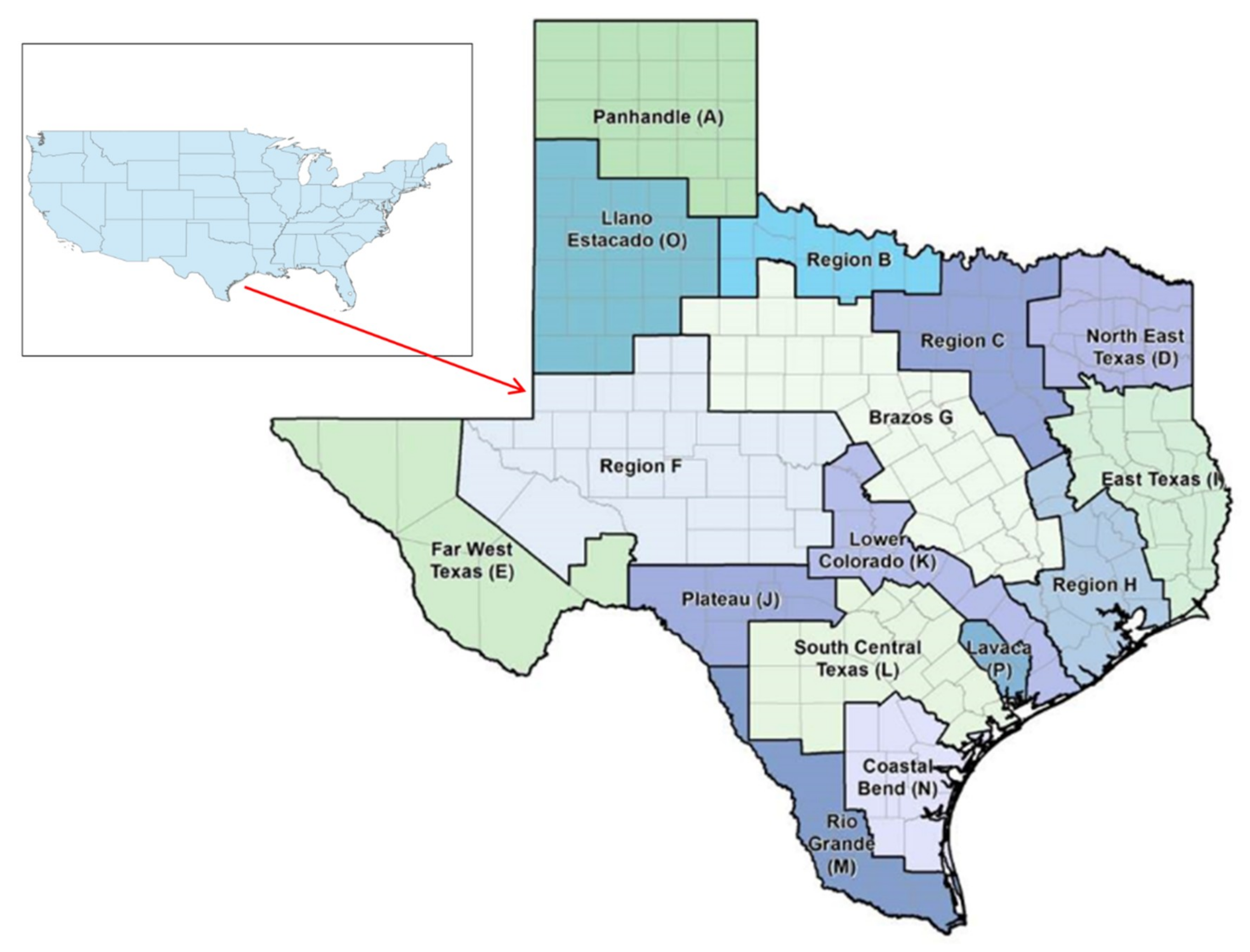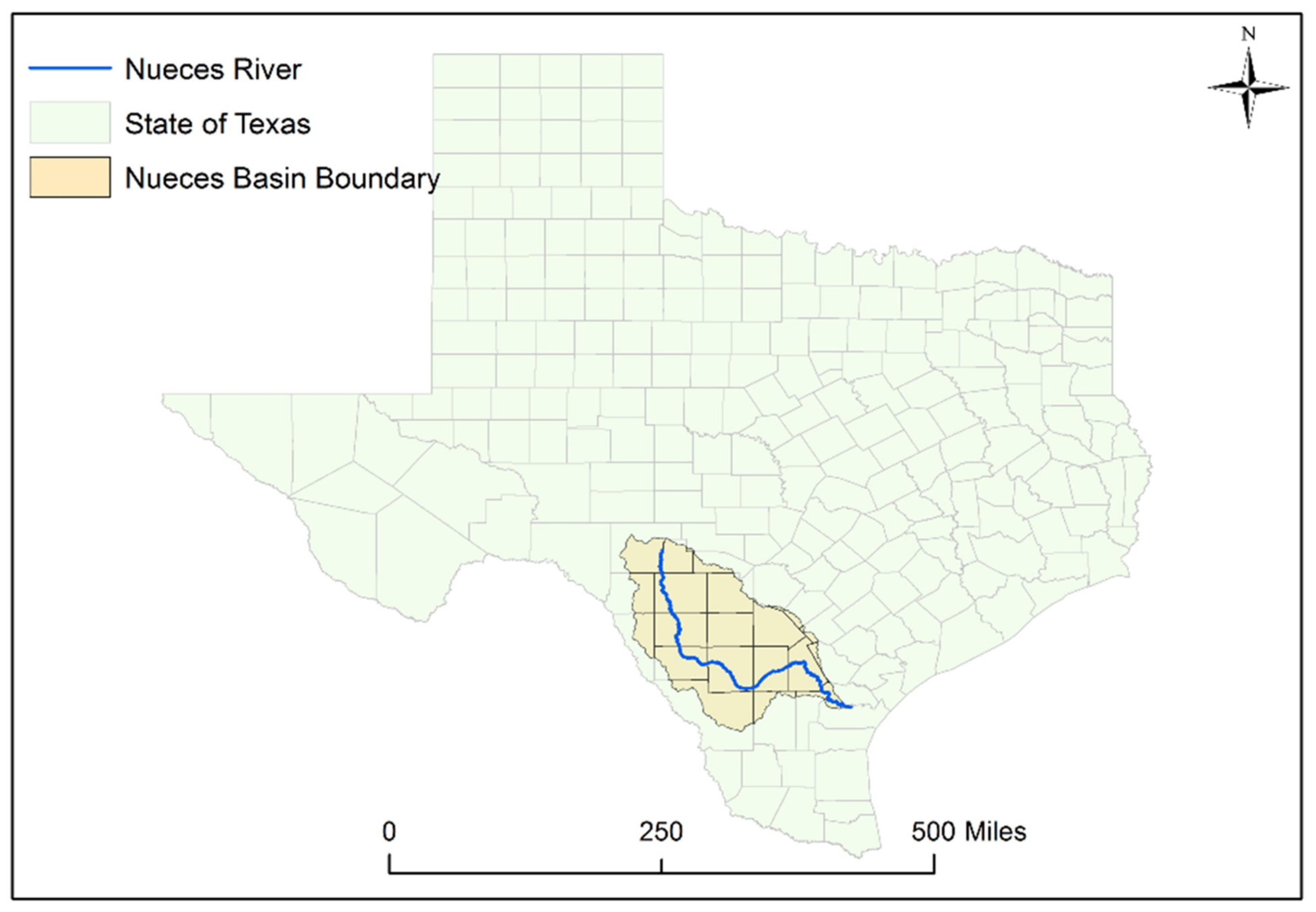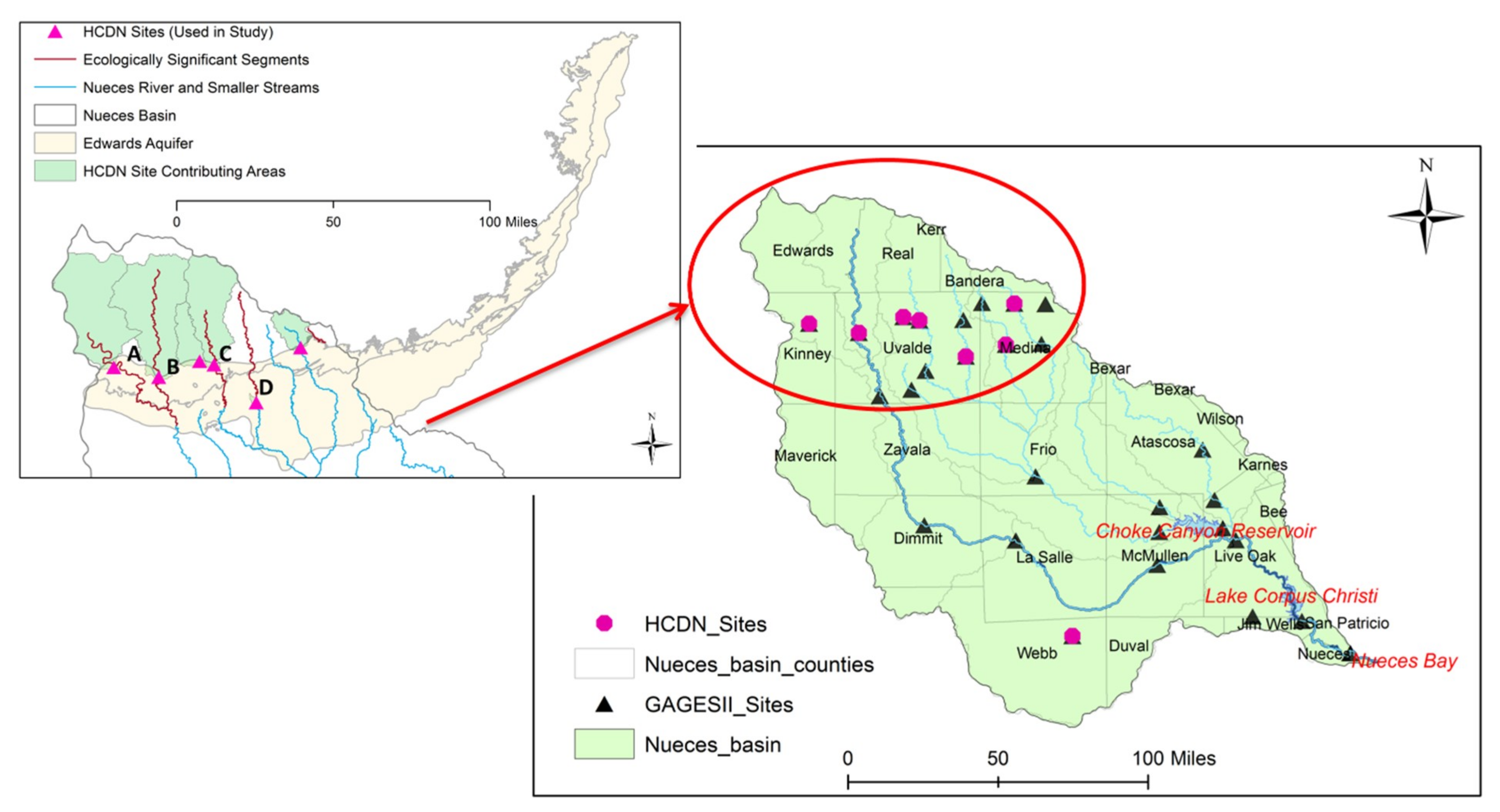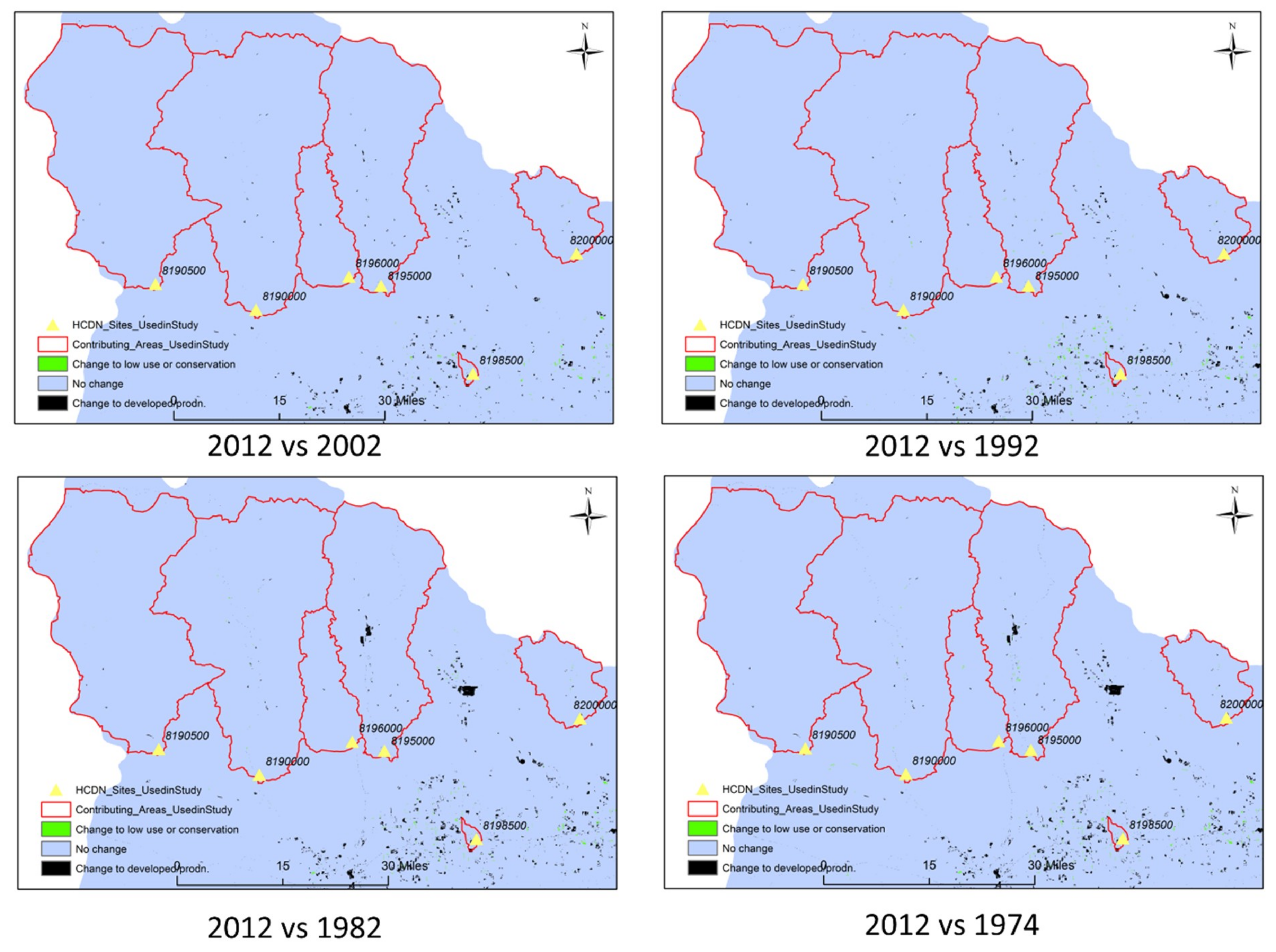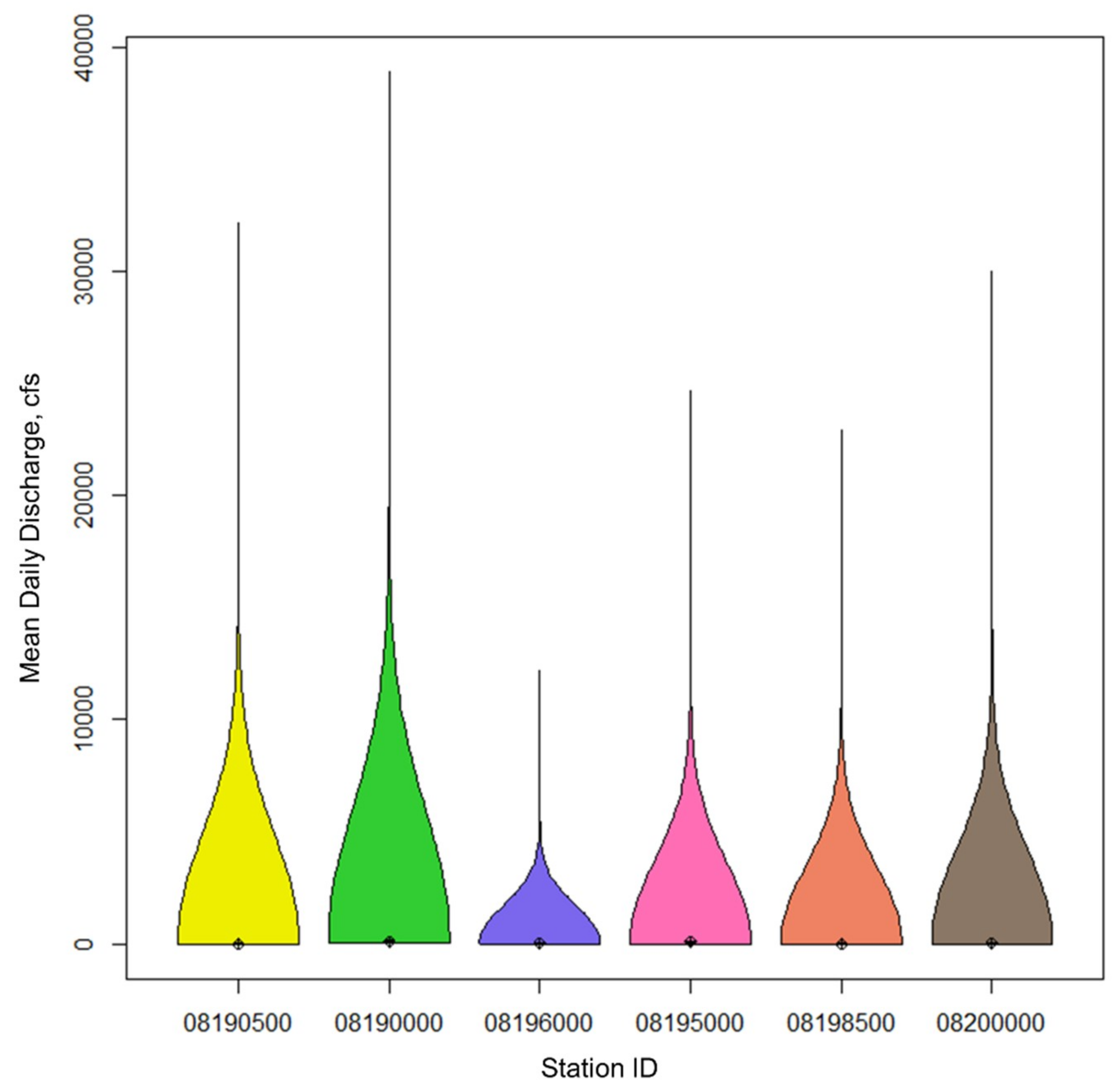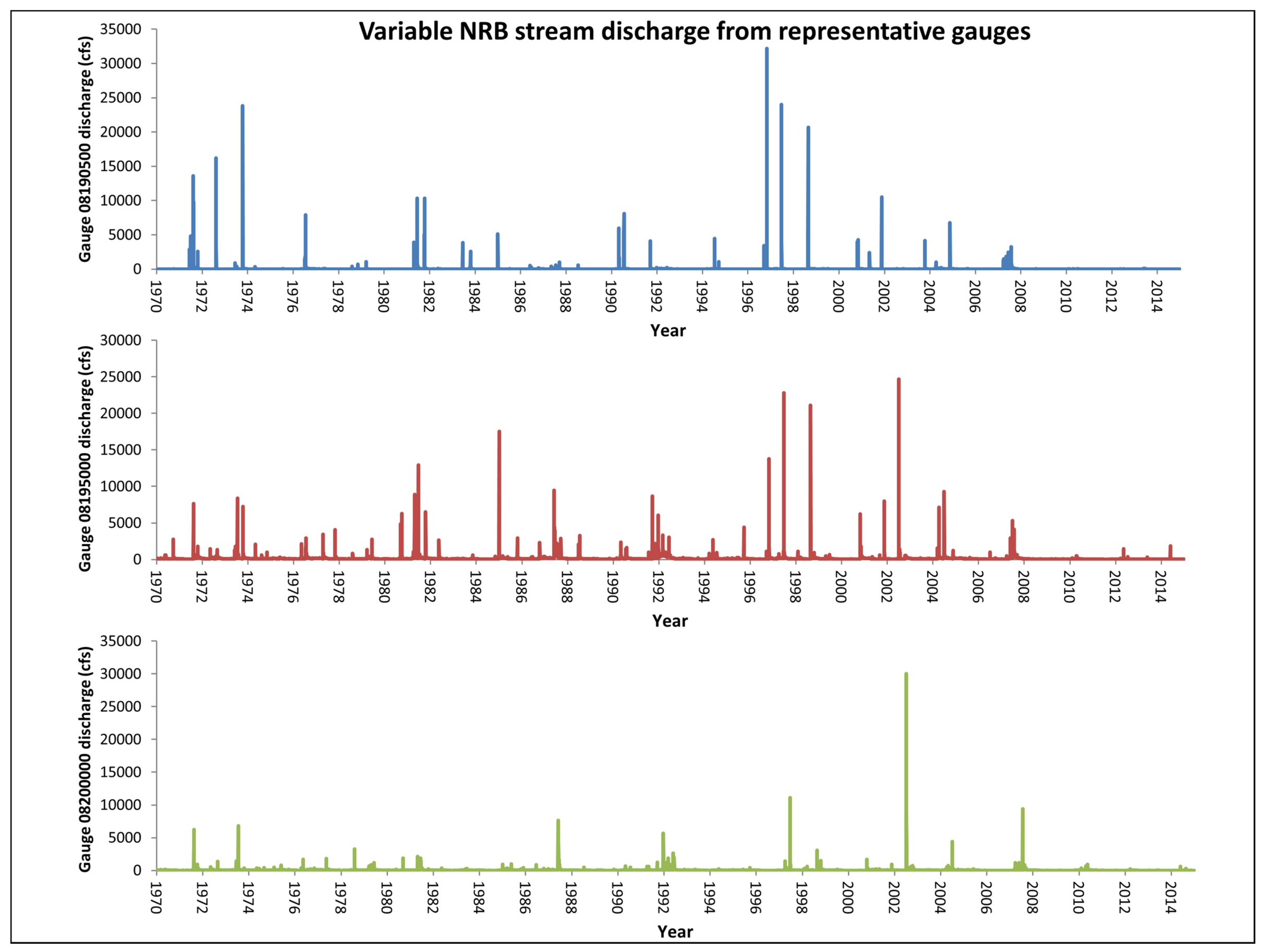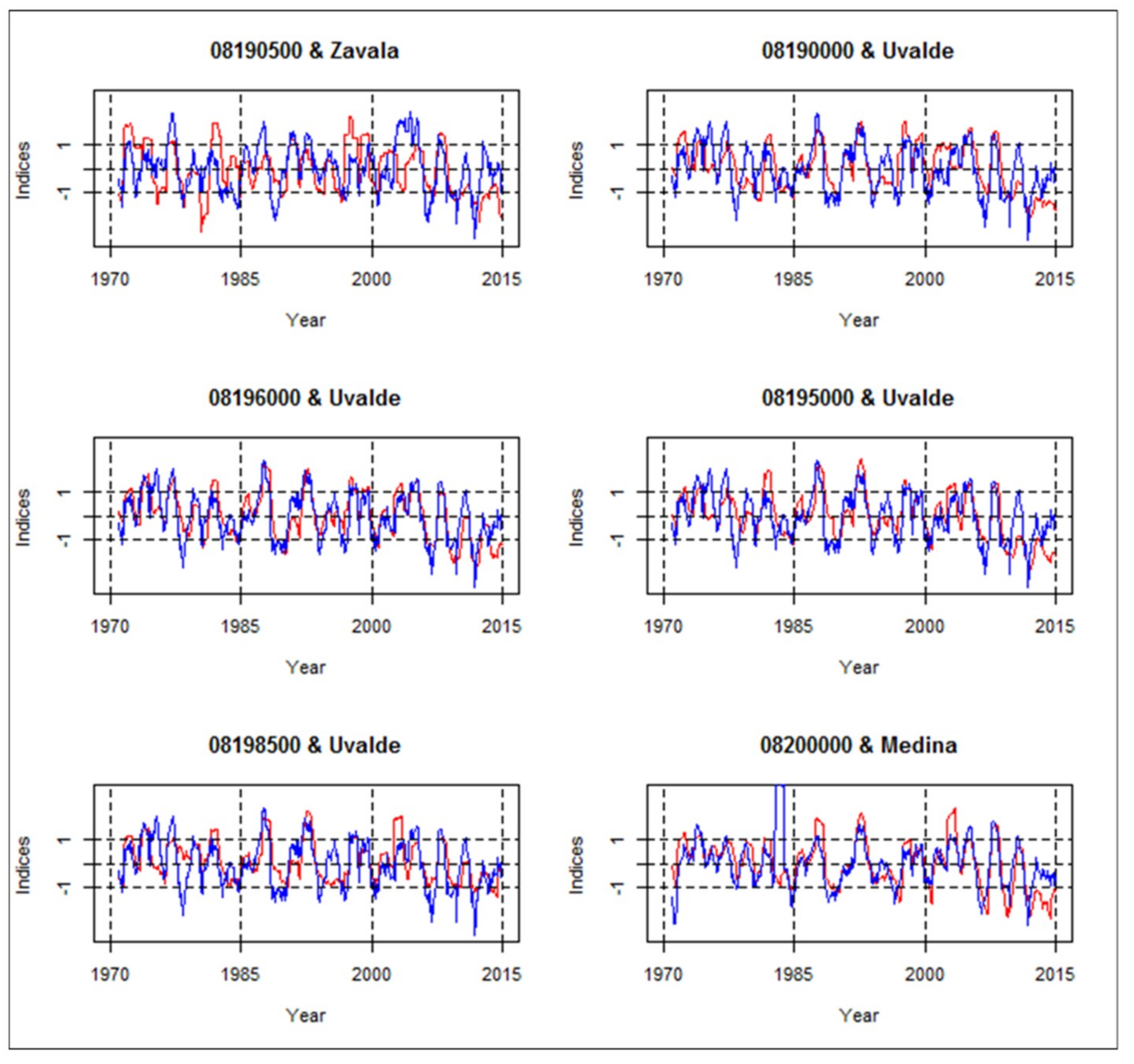1. Introduction
Access to fresh water resources plays a critical role in sustainable development, particularly in water-scarce regions. Semi-arid areas such as south Texas are highly water-stressed due to limited annual precipitation, high evapotranspirative losses, and prolonged droughts [
1,
2] as well as competing water demands [
3]. Annual rainfall in this region varies from about 20 inches to 40 inches but annual potential evapotranspiration exceeds precipitation by 2 to 5 times [
1].
Future climate change effects are not expected to bring any respite to water woes in the region either. The authors of [
4] projected a trend towards more dry days as well as warming temperatures in this region, likely leading to increased evapotranspirative losses. Conclusions drawn by the researchers of [
5] indicated that there may be no significant change in the amount of precipitation over the next 100 years, but rather that the duration between successive precipitation events will increase in the region. Several recent studies, for example [
6,
7,
8], have shown that increasing temperatures may lead to greater unpredictability in precipitation patterns, which will in turn impact streamflow. These studies also emphasized the increased propensity for extreme hydrologic events such as droughts and floods in the future, resulting in negative impacts on water resource management and on aquatic ecosystems, particularly with regards to environmental flows.
Furthermore, the authors of [
4] reported that variations in streamflow in the United States are predominantly caused by precipitation. Elsewhere, as in southwestern Australia, streams changed from perennial to ephemeral flow because of sharp declines in precipitation during the mid to late 2000s [
9]. Several studies, for instance [
10,
11] have used the concept of elasticity developed by [
12] to evaluate the changes in streamflow in response to changes in hydrologic variables such as precipitation or environmental variables such as land use and land cover.
As such, the south Texas region is characterized by large inter-annual variability in precipitation which results in uncertain streamflows, rendering them an unreliable source of water supply [
1]. For instance, highly irregular rainfall characteristics in the NRB result in brief periods of high flows interspersed between long spells of low or zero flows [
13]. Approximately 2% of the south Texas region consists of perennial water bodies; despite the sparse occurrence of surface water and the sporadic nature of streams in the region, most urban areas (with the exception of San Antonio) rely on surface water supplies to meet their needs.
Upon the passing of Senate Bill 1 (1997), water planning in Texas became a regional process, which required the Texas Water Development Board [TWDB] to identify 16 regional water planning regions (RWPAs). Of these, the majority of the NRB covers Region L (South Central Texas), but also extends into Region J (Plateau), Region M (Rio Grande), and Region N (Coastal Bend) as shown in
Figure 1. The European Union has also adopted a similar style of regional water planning with their River Basin Management Plan [
14]. The NRB is also a significant source of water for Region N, particularly for the City of Corpus Christi. According to [
15], two of the three reservoirs that serve this city, Choke Canyon Reservoir and Lake Corpus Christi [jointly referred to as CCR/LCC], are located on the NRB. As such, the State of Texas owns all surface water in the state and appropriation thereof is governed by water rights; for example, water stored in the CCR/LCC represents nearly 98% of the water rights in the basin. However, the reliability of these rights is contingent on hydrologic conditions, particularly the occurrence of droughts. Another study [
16], found that while droughts are common in this region, their severity has progressively increased; meanwhile, annual inflows to the CCR/LCC system have decreased by 40% from the 1950s to the 1990s. An 83% increase in total water use in Region N over the next 50 years has also been projected, underlining the need for prudent planning of water supply and use.
The NRB is unique from a hydrologic perspective due to the complex interactions that occur between streamflows and the subsurface environment, which can significantly alter groundwater recharge and thus indirectly impact water availability. One of the most productive karst aquifer systems in the world, the Edwards Aquifer of Texas, serves the water needs of the south-central Texas region, including the city of San Antonio, and supports several endangered species such as the Texas blind salamander (
Typhlomolge rathbuni). This system receives significant recharge contributions from above-ground sources such as the Nueces River [
18,
19,
20]. About 60% of the drainage basin recharges the groundwater system with about 14 billion ft
3 of water per year [
21]. Roughly 85% of Edwards Aquifer’s recharge comes from the watershed while the remainder originates from direct precipitation and subsurface flows from neighboring aquifers such as the Trinity [
22]. The Nueces River, in turn, receives contributions from surface runoff as a result of rainfall events as well as groundwater (in the form of springs). The authors of [
13] emphasized that the upper portion of the NRB that overlies the Edwards Aquifer outcrop region is “of particular interest to water managers in south-central Texas because appreciable streamflow gains and losses are observed along various reaches in the area”. In addition to its hydrologic value to the Edwards Aquifer and the reservoir systems that supply the Coastal Bend region, parts of the Nueces River have also been deemed to have significant ecological value, which is determined by criteria such as biological function, hydrologic function, the presence of threatened, endangered, or unique communities [
23].
While there is an abundance of literature on (a) short-term or prevailing hydrologic conditions and water quality in the basin in the form of United States Geologic Survey [USGS] scientific reports (e.g., [
13,
24,
25]), (b) the environmental conditions of downstream sections of the basin such as the Nueces estuary and associated ecosystem (e.g., [
26,
27,
28]) and (c) groundwater-river water interactions in the basin (e.g., [
18,
29,
30]), few studies have focused on hydrologic trends and their impacts on the basin, particularly on the upstream-most segments designated as ecologically-significant. Additionally, literature on the impact of variations, if any, in precipitation and land use and land cover (LULC) on streamflow in this basin is lacking.
It is apparent from the preceding discussion that alterations in streamflow of the upper Nueces River and those of its associated tributaries such as the Frio and Sabinal can have adverse consequences on inflows in to the CCR/LCC systems. This in turn will affect water availability in the Coastal Bend region, critically-impact recharge to the Edwards aquifer, as well as detract from the ecological uniqueness of areas designated as such. The sporadic nature of the river as well as its history of recurrent droughts led the authors of [
1] to label the climate of this region as ‘problematic’. The over-arching goal of this study is, therefore, to evaluate the variability in streamflow in the upper-most part of this basin [near the headwaters] both from a water-planning perspective as well as for stream health assessment reasons. Specifically, we investigate historical spatio-temporal trends in streamflow using a suite of hydrologic indicators to identify any congruity between these metrics and variables such as precipitation and evapotranspiration (ET) in streamflow. The period of 1970 to 2014 was chosen for this study as consistent and reliable data for both streamflow and climate variables are available for this timeframe. Gauges that are part of the USGS HCDN 2009 were used as they reflect on sites with minimal or no human interference or disturbance.
4. Discussion
This study used a collection of hydrologic indicators to robustly investigate the hydroclimatic relationships of ecologically significant streams in the upper regions of the NRB and the potential impacts of hydrologic alterations for the period 1970 to 2014. The novel aspects of this study are that we (a) have focused on the upper-NRB where the ecologically significant segments lie and where no literature regarding the impact of hydrologic changes on these segments exists and (b) use a diverse suite of hydrological indicators to capture the response and sensitivity of the river to changes in external drivers. We have also updated the most recent time series used in hydroclimatic analyses of the NRB by the authors of [
21] from 2009 to 2014. Additionally, we make recommendations to policy-makers and natural resource managers on holistic and sustainable approaches to water resource planning in the region.
The results showed occurrences of statistically significant streamflow declines in the selected gauges, but precipitation in the corresponding counties overwhelmingly showed no trends. The MMK assessments detected significant decreasing stream discharge trends in the central to easternmost gauges, mainly in Q
min and Q
med for the 1970 to 2014 period, as well as more uniform declines over each flow level (Q
min, Q
med, and Q
max) for the westernmost and central gauges during the most recent 20 years of the study. The decreases in stream discharge were consistent with earlier studies of the spatiotemporal hydroclimatic relationships in the basin in [
32,
33], which concluded that runoff per unit precipitation in the Atascosa River Basin, a subbasin in the upper NRB, from 1935 and 1994 showed declining trends.
The droughts that were experienced in the NRB, particularly ones during last 15 years, were first manifested in the SPI followed by the SDI. The SPI, a precipitation based index, detected the trends in drought early on; whereas, the SDI, which is based on streamflow, also identified the drought trends but with an expected lag or delay. The lag between the two drought indices suggested that a relationship exists between precipitation and streamflow. The degree to which the hydroclimatic variables are related was shown to be moderate to high by the streamflow-precipitation elasticity. However, because statistically significant decreases in precipitation were only detected in Uvalde County during spring, fall, and the months of April for the 45-year study period, it was clear that precipitation was not the only reason for stream discharge declines. The authors of [
63] indicated that precipitation that eventually becomes streamflow generally encounters a lag period because of factors such as basin size and antecedent soil moisture. Consequently, the precipitation reductions in the fall seasons coupled with extended lag times could have led to streamflow declines in the successive fall and winter periods. Plus, with the statistically significant declines in spring precipitation, decreased flows in Q
min and Q
med were mainly detected in gauges in Uvalde County during that season. Summer and its corresponding months virtually showed very few statistically significant decreasing trends in streamflow for both 45- and 20-year time periods. Texas’ semi-arid to arid climate experiences hot summers [
37] and variable precipitation [
1]. During summer months, many Texas streams suffer from reduced and in some cases zero flows. Therefore, the typical summer conditions could possibly explain why practically no streamflow trends were detected during that time period. However, due to the demonstrable lack of statistically significant precipitation trends, it was apparent that other reasons contributed to the declining streamflows.
The authors of [
63] noted that stream discharge trends sometimes do not reflect changes in precipitation because of a combination of climatological variables. The dataset from [
45] assessed changes in actual ET trends from 1979 to 2015, and it was used as a surrogate for temperature variation for each gauge location. The effects of ET on streamflow, however, were not conclusive for either the annual 45- or 20-year periods. The assessments from [
45] indicated that changes in ET trends were positive in the western areas of the basin, which suggests that ET had a greater effect on the westernmost gauges (08190500 and 08190000). The central to easternmost gauges (08196000, 08195000, 081985000, and 08200000) all experienced little to no impact from ET as the [
45] dataset showed negligible changes in ET trends in those areas. The ET results were not indicative of the likely locations for decreasing discharge in the 45-year period as trend analyses showed that streamflow declines overwhelmingly occurred in the central to easternmost gauges. When the changes in ET trends were compared with the annual decreases seen in the last 20 years, only in Q
max did statistically significant declines often occur in the western portion of the basin, where changes in ET trends were also positive. In the other flow levels, no significant trends were found for Q
min while Q
med only experienced decreases in the locations that span the central to eastern gauges. Similar to the 45-year period, the trend analyses in Q
med for the 20-year timespan conflicted with the ET findings which showed that the central to eastern areas had the least ET effect. The general discrepancy between the streamflow and changing ET trends was likely because the ET assessments were not basin-specific as noted by the researchers of [
64]. The authors suggested that hydroclimatic variables should be analyzed at the local rather than regional scale for the most accurate analysis since trend effects on extensive scales essentially normalize the final result which may not account for the subtle variances on a localized level. Consequently, other environmental factors were considered.
As previously mentioned, [
43] documented U.S. LULC trends from 1974 through 2012 using GIS analysis. Different land uses either impede or facilitate stream discharge. Therefore, investigating temporal changes in land use from being under conservation to being developed with time was necessary to indicate if the NRB region was affected by manmade influences that would have altered the basin’s hydrological characteristics, hence affecting the area’s HCDN status. The analysis indicated that the NRB had undergone LULC alterations, particularly in its southern end, as shown in
Figure 4. More importantly however, the analysis revealed that the upper-most basin regions, which contribute to the gauges in our study, remained virtually unchanged during the 1974 to 2012 timespan with only marginal modifications to undeveloped areas thereby fulfilling the HCDN’s minimal anthropogenic disturbance criteria. As
Figure 4 also highlights, the most modified regions fed the 08195000 and 08198500 gauges, both in Uvalde County, and those changes occurred sometime within the period of 1974 to 1982.
Vegetative cover, and by extension LULC, directly impact different areas of the hydrological cycle such as soil moisture, ET, runoff, and infiltration [
48,
65] as well as streamflow. Greater vegetative cover buffers precipitation and ultimately decreases runoff, and as a consequence, stream discharge [
66]. Some brush species also impact certain hydrologic processes as they alter spring flows and stream discharge that is interconnected with aquifer systems [
67]. As a result, land use changes in the NRB, while minimal, could have still impacted the hydrological dynamics in the region. Furthermore, studies by [
68,
69] explain that land use changes can lead to declines in stream discharge in areas that are susceptible to low flows. The minimal LULC modifications could therefore signal an increase in human consumption along the course of the different stream segments, potentially leading to decreased streamflows as less water arrives to the HCDN gauges.
The authors of [
49,
51,
63] all agree that when stream discharge trends show results that are inconsistent with climatological variation, anthropogenic influences such as water management might be a reason for the changes. As mentioned previously, Texas’ state-owned water is managed using water rights, which are granted to select users via water rights permits. The Texas Watermaster Program enforces water permits, but only in a handful of watersheds such as the Rio Grande and Brazos does the body manage the entire river basin. In the case of the NRB, some regions are under the control of the South Texas Watermaster [
70], but the upper sections, which were part of our study, are not. Therefore, water rights owners exceeding their water use quotas could be another possible reason why the declines were detected by the gauges. Additionally, many water permit holders have access to the ecologically significant stream segments that were studied. Their water usage activities are concentrated upstream of the gauges and primarily involve diversion points, which are authorized locations on the channel of a stream where water can be legally removed. After closer review of the non-Watermaster records, it was confirmed that many permit owners, particularly in Uvalde and Medina Counties, are found in areas without Watermaster supervision. The impact of watershed management practices on water quality trends in rivers in the United States has also been recently pointed out by [
71].
Furthermore, water used by permit holders in the non-Watermaster areas are supposed to be annually self-reported [
72]. When archived reports for the previously named counties were evaluated from [
72], some permittees did not report their usage during different time periods, which is mandatory even if they did not utilize their designated quotas [
73]. Therefore, should permit holders who operate in non-Watermaster areas subvert the honor system and not comply with their permits, they could potentially overuse and underreport the amount of water that they were assigned. Years of sustained overexploitation could have been reflected in the declining stream discharge, particularly during low streamflow periods, which could explain why the low flow metrics showed instances of statistically significant decreases. Water rights are prioritized based on seniority among permit owners using priority dates, so permittees with earlier water rights are given greater preference during lower flow periods [
74]. Consequently, users in non-Watermaster areas could withdraw more than their permits allow, yet go unnoticed unless more senior water rights holders are impacted to the point that they file complaints for investigation.
5. Conclusions
In conclusion, the study used a collection of hydrologic metrics (MMK trend analyses, low flow indicators, streamflow-precipitation elasticity, as well as drought indices) on six USGS gauges in the upper NRB to robustly investigate the area’s hydroclimatic relationships and the potential impacts of those associations to south Texas. The hydroclimatic analyses of the chosen stream gauges showed the relationship between the studied hydrological variables in the upper NRB existed. The assessments also detected significant decreasing stream discharge trends in a number of gauges for both the 1970 to 2014 period and during the last 20 years of the study. Although the causes of the declining streamflow trends could not be totally attributed to rainfall fluctuations, a combination of other climatological, environmental, and water management factors were assessed as probable contributors to reductions in flow. The decreasing trends should be of concern, however. The declining stream discharge could see negative impacts on the stream segments that were designated as ecologically significant, particularly for their hydrologic, biological, and ecological functions to the NRB, and by extension, south Texas. More importantly, the fact that decreasing streamflow was detected in all of the gauges at some point or the other over the study period should be of interest to the region’s water and natural resource managers as the declines may have implications for current as well as future water-planning and aquatic health. It must also be noted that our findings will likely have broader impacts beyond the NRB considering that other parts of the state have stream segments designated as ecologically-significant. As indicated in [
75], these include segments in Regions C, H, J, K, and L, shown in
Figure 1 for spatial reference.
Continued declining stream discharge trends could directly impact the hydrologic functions of the NRB and potentially lead to negative implications for the economic, agricultural, and industrial sectors for south Texas, as the region’s surface and groundwater supply heavily depends on the drainage basin. Additionally, if the streamflow that traverses the NRB down to Nueces Bay continues to decline, changes in water chemistry, disruptions to nutrient movement via nutrient spiraling, biological functions, biodiversity, natural organismal migration patterns, reproduction habits of aquatic life, as well as the overall ecological health of the region could be impaired. Further decreases in streamflow could spell even more danger for the already vulnerable endemic, threatened, and endangered populations and ecosystems of the Blanco blind salamander (
Eurycea robusta), Comal blind salamander (
Eurycea tridentifera), Plateau shiner (
Cyprinella lepida), and Blanco River Springs salamander (
Eurycea pterophila), for example, which are highlighted in [
23].
As it specifically relates to the Nueces Bay, reduced stream discharge could be detrimental to its aquatic species, and by extension, the fisheries industry in that marine environment. The researchers of [
31] noted that the Nueces Bay relies on the flows from the NRB to dilute the saline water to make the coastal location habitable for brackish water species. With decreasing stream discharge and rising global sea levels because of changes in climate [
76] as well as thermal expansion due to global warming [
77], the ability to buffer the saline conditions in the Nueces Bay would become more difficult and possibly make the coastal environment inhospitable to coastal marine life.
Furthermore, riverine plants, specifically riparian vegetation and macrophytes, play vital roles in freshwater environments and overall stream health such as, for maintaining water quality, biodiversity, spawning and breeding grounds, aquatic habitats, as well as bank stabilization [
78]. With sustained periods of unusual flow patterns such as reduced stream discharge, the diversity of riparian plant species changes from more to less water-tolerant [
79] thereby impacting the important functions riverine plants provide to lotic environments and emphasizing the detrimental effects declining flows could cause.
As seen in the results and preceding content, the effects of declining stream discharge could be detrimental to numerous aspects of ecological health as well as the hydrological balance of the NRB. Therefore, it is imperative that water managers and resource planners consider strategies to mitigate the potential impacts of such effects. The possible consequences of the distribution of water rights should be evaluated and the mechanisms to emphasize the significance of truthful reporting of water use quotas, particularly since the upper regions of the NRB is in a non-Watermaster area, should be considered.
